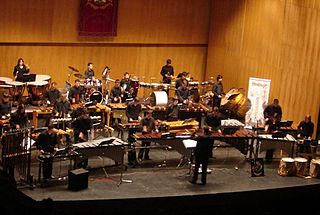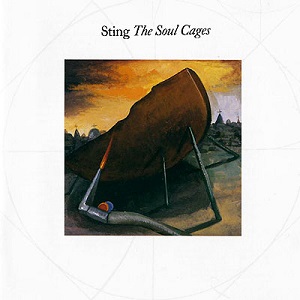
A percussion instrument is a musical instrument that is sounded by being struck or scraped by a beater including attached or enclosed beaters or rattles struck, scraped or rubbed by hand or struck against another similar instrument. Excluding zoomusicological instruments and the human voice, the percussion family is believed to include the oldest musical instruments. In spite of being a very common term to designate instruments, and to relate them to their players, the percussionists, percussion is not a systematic classificatory category of instruments, as described by the scientific field of organology. It is shown below that percussion instruments may belong to the organological classes of idiophone, membranophone, aerophone and cordophone.

John Milton Cage Jr. was an American composer and music theorist. A pioneer of indeterminacy in music, electroacoustic music, and non-standard use of musical instruments, Cage was one of the leading figures of the post-war avant-garde. Critics have lauded him as one of the most influential composers of the 20th century. He was also instrumental in the development of modern dance, mostly through his association with choreographer Merce Cunningham, who was also Cage's romantic partner for most of their lives.

Anthony Braxton is an American experimental composer, educator, music theorist, improviser and multi-instrumentalist who is best known for playing saxophones, particularly the alto. Braxton grew up on the South Side of Chicago, Illinois, and was a key early member of the Association for the Advancement of Creative Musicians. He received great acclaim for his 1969 double-LP record For Alto, the first full-length album of solo saxophone music.

Music for 18 Musicians is a work of minimalist music composed by Steve Reich during 1974–1976. Its world premiere was on April 24, 1976, at The Town Hall in New York City. Following this, a recording of the piece was released by ECM New Series in 1978.

Annie Gosfield is a New-York-based composer who works on the boundaries between notated and improvised music, electronic and acoustic sounds, refined timbres and noise. She composes for others and performs with her own group, taking her music to festivals, factories, clubs, art spaces and concert halls. Much of her work combines acoustic instruments with electronic sounds, incorporating unusual sources such as satellite sounds, machine sounds, detuned or out-of-tune samples and industrial noises. Her work often contains improvisation and frequently uses extended techniques and/or altered musical instruments. She won a 2012 Berlin Prize.

A percussion ensemble is a musical ensemble consisting of only percussion instruments. Although the term can be used to describe any such group, it commonly refers to groups of classically trained percussionists performing primarily classical music. In America, percussion ensembles are most commonly found at conservatories, though some professional groups, such as Nexus and So Percussion exist. Drumlines and groups who regularly meet for drum circles are two other forms of the percussion ensemble.

Timothy "Tim" George Hodgkinson is an English experimental music composer and performer, principally on reeds, lap steel guitar, and keyboards. He first became known as one of the core members of the British avant-rock group Henry Cow, which he formed with Fred Frith in 1968. After the demise of Henry Cow, he participated in numerous bands and projects, eventually concentrating on composing contemporary music and performing as an improviser.

The Soul Cages is the third full-length studio album released by English musician Sting. Released on 21 January 1991 it became Sting's second No. 1 album in the United Kingdom. This was Sting's first album to feature guitarist Dominic Miller, who would become a regular collaborator.
Credo in Us is a musical composition by the American experimental music composer, writer and visual artist John Cage. It was written in July 1942 and revised in October of that year. In the wake of Pearl Harbor, this piece avoided the populist tendencies of fellow American composers at the time, while the piece's title is thought to be a call to collective unity.

Variations is a classical and rock fusion album. The music was composed by Andrew Lloyd Webber and performed by his younger brother, the cellist Julian Lloyd Webber.
Music of Changes is a piece for solo piano by John Cage. Composed in 1951 for pianist and friend David Tudor, it is a ground-breaking piece of indeterminate music. The process of composition involved applying decisions made using the I Ching, a Chinese classic text that is commonly used as a divination system. The I Ching was applied to large charts of sounds, durations, dynamics, tempo and densities.
Construction is the title of several pieces by American composer John Cage, all scored for unorthodox percussion instruments. The pieces were composed in 1939–42 while Cage was working at the Cornish School of the Arts in Seattle, Washington, and touring the West Coast with a percussion ensemble he and Lou Harrison had founded. The series comprises three Constructions. A piece titled Fourth Construction, mentioned in several sources, is apparently either an unfinished work from 1942 or, more likely, an early title of the work we now know as Imaginary Landscape No. 2 .
Imaginary Landscape is the title of a series of five pieces by American composer John Cage, all of which include instruments or other elements requiring electricity. The series comprises the following works:

Imaginary Landscape No. 3 is a composition for six percussionists by American composer John Cage and the third in the series of Imaginary Landscapes. It is the last Imaginary Landscape to feature percussion instruments and, therefore, the last one to be considered a chamber piece. It was composed in 1942.

Imaginary Landscape No. 2 is a composition for five percussionists by American composer John Cage and the second in the series of Imaginary Landscapes. It was also the first march in the set, the second being Imaginary Landscape No. 4 . It was composed in 1942.

Jan Williams is a percussionist, arts administrator, teacher, conductor, and composer who has championed avant-garde and progressive music in the United States. He is recognized as an important proponent of percussion performance and its literature.
But what about the noise of crumpling paper which he used to do in order to paint the series of "Papiers froissés" or tearing up paper to make "Papiers déchirés?" Arp was stimulated by water, forests, sometimes shortened as But what about the noise..., is a composition for percussion ensemble by American composer John Cage. It was finished in 1985.

Imaginary Landscape No. 4 is a composition for 24 performers on 12 radios and conductor by American composer John Cage and the fourth in the series of Imaginary Landscapes. It is the first installment not to include any percussion instrument at all and Cage's first composition to be based fully on chance operations. It is also the second march in the set of Imaginary Landscapes, after Imaginary Landscape No. 2 . It was composed in 1951.

Imaginary Landscape No. 5 is a composition by American composer John Cage and the fifth and final installment in the series of Imaginary Landscapes. It was composed in 1952.










